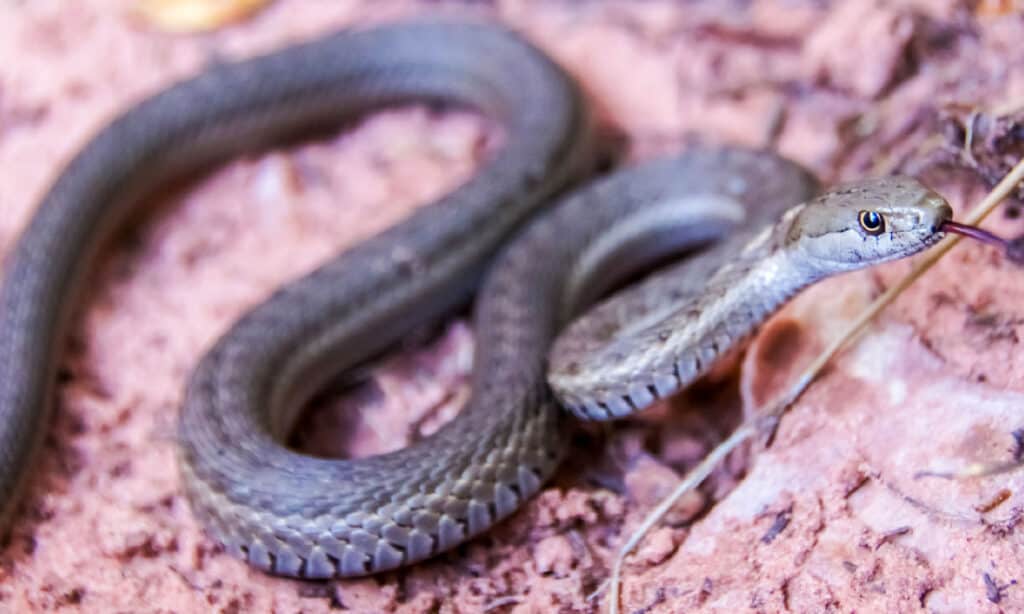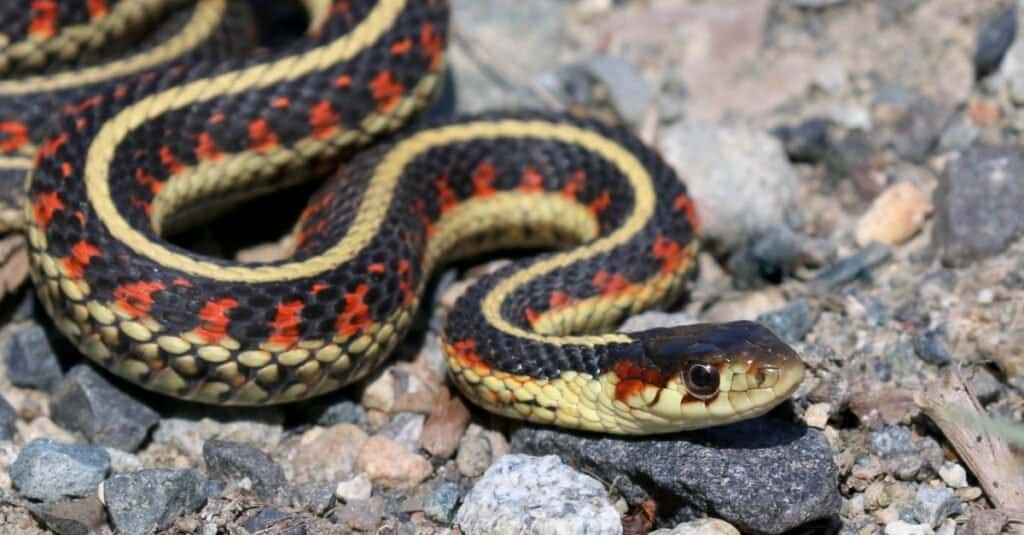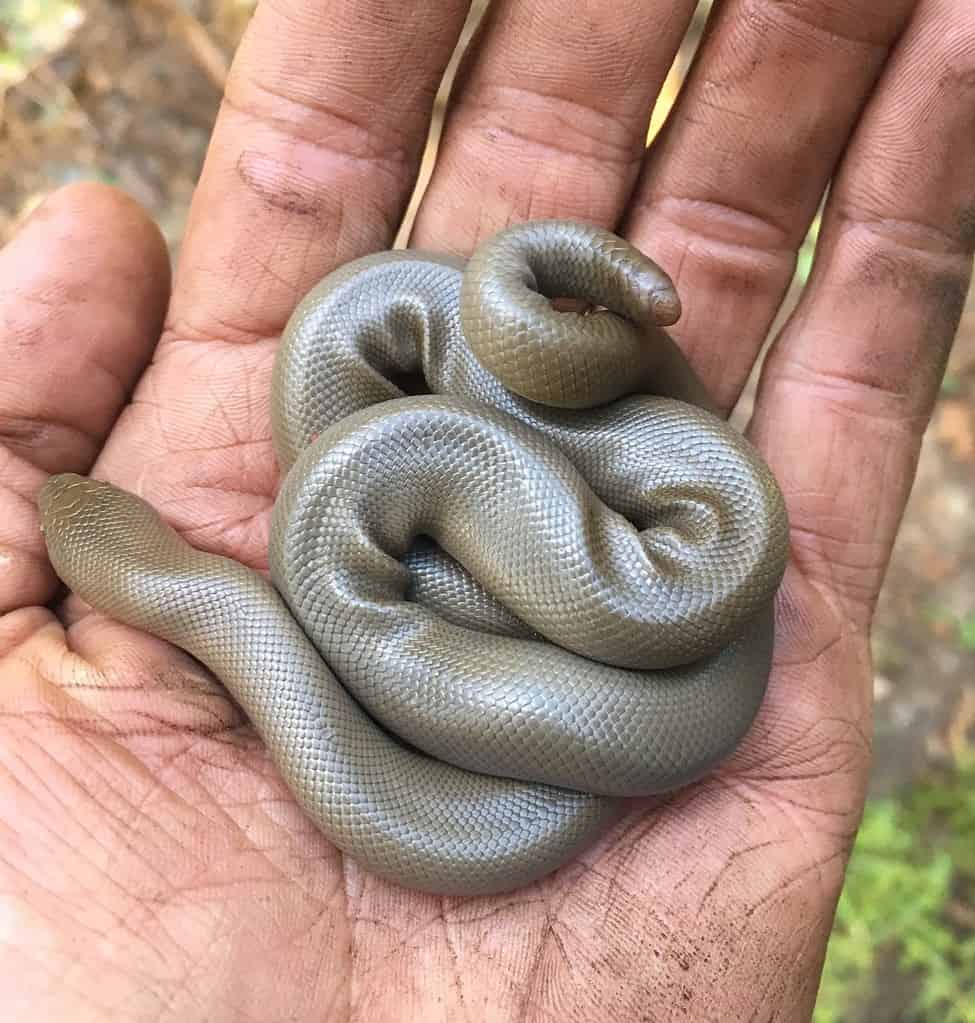Montana isn’t as attractive to snakes as other states, and there are only ten native species. However, you’ll find six of the Treasure State’s ten snakes slithering around Flathead Lake. Located in northwestern Montana, Flathead Lake is the remnant of a vast, ancient glacial lake. It has more surface area than any other natural freshwater body in the western United States and is one of the cleanest lakes in the world.
A glacier feeds Flathead Lake. The water is cold year-round, so if you plan on being in the water, a wetsuit is required! Still, boating and fishing are popular activities when you plan for the cold.
Like other animals, snakes need water. Some, like garter snakes, are semiaquatic and spend hours in the water, while others only drink the rainwater that gathers in their scales and get the rest of their water from the food they eat.
Let’s take a look at the six snakes you’ll find around Flathead Lake.

Flathead Lake’s water is some of the cleanest in the world.
©iStock.com/11jasons
When Snakes Are Most Active Around Flathead Lake
Montana’s climate makes a snake’s active season shorter than in states like Arizona. However, by late March or early April, you can bet the snakes are waking up. Garter snakes are usually the first to awaken and the last to retreat for the winter; they’re very tolerant of the cold. Other species often need a little more time to warm up before becoming fully active.
Generally, spring and fall bring the most snake sightings because they’re moving to and from brumation dens and other hiding spots or looking for a mate.
Western Terrestrial Garter Snake (Thamnophis elegans)
Flathead Lake’s most common serpentine resident is probably the western terrestrial garter snake. Although it is technically semiaquatic, this species is more comfortable further from water than other garter snakes. Its diet is flexible and reflects whatever prey they find, including insects, worms, and amphibians.
Western terrestrial garter snakes are long and thin, with a larger head than other garter snakes. While most garter snakes do not constrict their prey, they just swallow it live, western terrestrial garter snakes do constrict their prey. However, they’re not very good at it and often take much longer to kill the animal.
Most of these snakes have yellow, white, or light orange dorsal stripes, but not all. They’re sometimes difficult to identify because their patterns and colors vary widely! Western terrestrial garter snakes have mildly venomous saliva that helps disable their prey but isn’t dangerous to people. These snakes can grow to about 41 inches long.

Most western terrestrial garter snakes have three stripes down the length of their bodies — a dorsal stripe and one stripe on either side, just above the belly.
©iStock.com/yhelfman
Common Garter Snake (Thamnophis sirtalis)
Garter snakes galore! These long, thin snakes sometimes have red on their sides and almost always have a lighter-colored dorsal stripe. It’s no surprise that garter snakes are high on our list of common snakes around Flathead Lake — they’re semiaquatic. These snakes prefer eating small fish, frogs, salamanders, and earthworms.
Common garter snakes can be one of several subspecies, and sometimes, even experienced herpetologists have difficulty confidently identifying them. These snakes can reach 48 inches but are often quite a bit smaller. Although they are harmless to humans, garter snakes also have mildly venomous saliva and slightly enlarged teeth in the back of their mouths. They use it to disable prey; according to scientists, it’s very effective.

Valley garter snakes have larger eyes and smallish heads.
©iStock.com/randimal
Northern Rubber Boa (Charina bottae)
Rubber boas have very small shiny scales, loose skin, small eyes, and a blunt tail. The most northerly-living, cold-adapted of all boas looks like wet rubber. They range from brown to olive green with cream or yellow bellies.
Northern rubber boas are extremely gentle snakes that almost never bite. The snakes are small, only growing to about 28 inches. Rubber boas are fossorial and spend much of their time underground, hunting rodent burrows. They’ll often eat entire nests of baby rodents while fending off the parents with their tails.

Rubber boas’ heads and tails look similar; it may be hard for predators to figure out which end is which!
©Matt Berger / CC BY 4.0 – License
North American Racer (Coluber constrictor)
Known for leglessly speeding around and startling people. Yet, these harmless snakes with big, friendly eyes want nothing more than to eat small rodents, birds, and the occasional snake, including rattlesnakes. Around Flathead Lake, these snakes are likely to stick to the grassy or shrubby cover and occasionally pop their heads above it all to see where they’re going.
North American racers are common throughout their range and have several colors. In Montana, you will most likely encounter a western yellow-bellied racer (C. c. mormon). They’re usually green, blue, or brown with noticeably yellow bellies and often grow to six feet long.

There are several North American racer subspecies named for their color and location.
©Michael Chatt/Shutterstock.com
Bullsnake (Pituophis catenifer sayi)
One of the biggest snakes in North America, bullsnakes are a type of gopher snake. They can get close to eight feet long and are very muscular. People often confuse them for rattlesnakes because they have a similar pattern. Of course, they’re also master bluffers. Bullsnakes rattle their tails against the ground, hiss loudly, and rub their scales together. They may even mock-strike you with a closed mouth — so it’s more of a head-butt.
For all their bravado, bullsnakes are harmless. Bullsnakes often use abandoned or recently cleared rodent burrows for shelter at night or when the day is at its hottest. These diurnal predators hunt in open grasslands and sandy areas — preferring more arid habitats. You’re likely to spot these snakes cruising in the areas a little further inland around Flathead Lake, only visiting the water on the hottest days.

Bullsnakes are harmless but have similar patterns to the infamous rattlesnakes.
©GoodFocused/Shutterstock.com
Prairie Rattlesnake (Crotalus viridis)
The only venomous snake in Montana comes with an early warning system. Of course, no system is perfect, and rattlesnakes can’t always rattle a warning. However, unless you are a tasty rat or mouse, prairie rattlesnakes are more interested in getting away from you.
These snakes aren’t quite as nervous as western diamondback rattlesnakes. However, they’re still venomous and can grow up to five feet long. Their fangs can be a half-inch long and are attached to some impressive venom glands. However, the easiest identification is with the banded tail that ends in a rattle. If it has a rattle, it’s venomous.
Prairie rattlesnakes are excellent swimmers who sometimes hunt actively. Yet these ambush predators prefer spending most of their time coiled up in a cozy crevice or basking. They’re more likely to wait for food to stumble close enough to strike. For humans, a bite means a hospital trip, possibly antivenom, and sometimes a lengthy recovery. But for a mouse, it’s a quick death.

Rattlesnakes usually rattle to warn away people and bigger animals, but they don’t always rattle.
©DMartin09/Shutterstock.com
What to Do if a Rattlesnake Bites You
This is where most people make mistakes. Yet, who wouldn’t be frightened when a venomous snake bites them? The good news is that as many as 25% of rattlesnake bites are dry, which means they didn’t inject venom. Some believe that the idea of sucking out the venom became popular because some bites were dry. If you didn’t know that, it could easily have looked like sucking out the venom worked.
Snakebite First Aid
Some older first-aid guides recommend making an incision over the bite wound and trying to suck out the venom. Don’t do this. Snake fangs are curved, meaning that the venom doesn’t have a straight path out of the body.
Here are a few more things to avoid in the case of a rattlesnake bite:
- Do not use a tourniquet
- Do not ice the bite location
- Don’t attempt to suck out the venom with your mouth or a suction device. Even if you tried to suck out the venom, you would only get about 1/10,000th of the venom injected.
- Don’t make any incisions over the wound.
Most of the approximately 8,000 venomous snakebites annually in the U.S. do not cause fatalities. By following a few simple snakebite tips, you’ll be able to minimize the damage done by the venom.
- Stay calm!
- Get to a hospital or dial 911
- Wash the bite with soap and water
- Remove all constrictive jewelry — watches, rings, etc.
- Immobilize the area and keep it below the heart if possible.
What to Do When You See Wild Animals
Most wild animals will take off before or shortly after they see you — and you may not even know it! In most cases, the best advice is to admire them from a distance. Take photos and create memories, but don’t approach them.
When you see a snake, don’t panic. Take a breath and remember that they also want to be left alone, and most will leave by themselves if you give them the space to do so.
If you’re camping or hiking in the area and need help moving an animal so you can safely get to your campsite or vehicle, contact a ranger or other park official. There are over 160 miles of shoreline around Flathead Lake and six lake units, so your best point of contact is with the lake unit closest to you.
Other Animals Around Flathead Lake
Flathead Lake is home to myriad animals, from the ground to the sky. Its rich, varied ecosystem is full of life — here are a few of the animals you might see if you’re hiking or fishing Flathead Lake.
- Goldenrod crab spider (Misumena vatia): Crab spiders are unique and can walk sideways, forward, and backward. Goldenrod crab spiders often use goldenrod sprays as hunting grounds. They’re common across much of North America, but aren’t very big — females grow up to 0.39 inches, and males are about half of that size.
- Bald eagle (Haliaeetus leucocephalus): A symbol of freedom for many, bald eagles were once in danger of extinction. However, its population recovered throughout its North American range. The region around Flathead Lake is a stopping point for some migratory bald eagles, but others live there all year.
- White-tailed deer (Odocoileus virginianus): These large deer can weigh up to 275 pounds. They’re common throughout the hills and valleys surrounding Flathead Lake.
| Snake | Venomous? |
|---|---|
| Western terrestrial garter snake | Mildly venomous saliva; not dangerous to humans. |
| Common garter snake | Mildly venomous saliva; harmless to humans. |
| Northern rubber boa | No |
| North American Racer | No |
| Bullsnake | No |
| Prairie rattlesnake | Yes!! Seek medical attention if bitten by one. |
The photo featured at the top of this post is © iStock.com/11jasons
Discover the "Monster" Snake 5X Bigger than an Anaconda
Every day A-Z Animals sends out some of the most incredible facts in the world from our free newsletter. Want to discover the 10 most beautiful snakes in the world, a "snake island" where you're never more than 3 feet from danger, or a "monster" snake 5X larger than an anaconda? Then sign up right now and you'll start receiving our daily newsletter absolutely free.
Thank you for reading! Have some feedback for us? Contact the AZ Animals editorial team.






